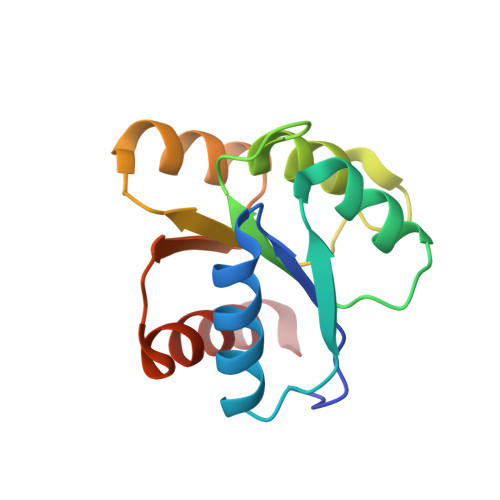Role of Position K+4 in the Phosphorylation and Dephosphorylation Reaction Kinetics of the CheY Response Regulator.
Foster, C.A., Silversmith, R.E., Immormino, R.M., Vass, L.R., Kennedy, E.N., Pazy, Y., Collins, E.J., Bourret, R.B.(2021) Biochemistry 60: 2130-2151
- PubMed: 34167303
- DOI: https://doi.org/10.1021/acs.biochem.1c00246
- Primary Citation of Related Structures:
3MYY, 3OO0, 3OO1 - PubMed Abstract:
Two-component signaling is a primary method by which microorganisms interact with their environments. A kinase detects stimuli and modulates autophosphorylation activity. The signal propagates by phosphotransfer from the kinase to a response regulator, eliciting a response. Response regulators operate over a range of time scales, corresponding to their related biological processes. Response regulator active site chemistry is highly conserved, but certain variable residues can influence phosphorylation kinetics. An Ala-to-Pro substitution (K+4, residue 113) in the Escherichia coli response regulator CheY triggers a constitutively active phenotype; however, the A113P substitution is too far from the active site to directly affect phosphochemistry. To better understand the activating mechanism(s) of the substitution, we analyzed receiver domain sequences to characterize the evolutionary role of the K+4 position. Although most featured Pro, Leu, Ile, and Val residues, chemotaxis-related proteins exhibited atypical Ala, Gly, Asp, and Glu residues at K+4. Structural and in silico analyses revealed that CheY A113P adopted a partially active configuration. Biochemical data showed that A113P shifted CheY toward a more activated state, enhancing autophosphorylation. By characterizing CheY variants, we determined that this functionality was transmitted through a hydrophobic network bounded by the β5α5 loop and the α1 helix of CheY. This region also interacts with the phosphodonor CheA P1 , suggesting that binding generates an activating perturbation similar to the A113P substitution. Atypical residues like Ala at the K+4 position likely serve two purposes. First, restricting autophosphorylation may minimize background noise generated by intracellular phosphodonors such as acetyl phosphate. Second, optimizing interactions with upstream partners may help prime the receiver domain for phosphorylation.
- Department of Microbiology and Immunology, The University of North Carolina at Chapel Hill, Chapel Hill, North Carolina 27599, United States.
Organizational Affiliation:

















